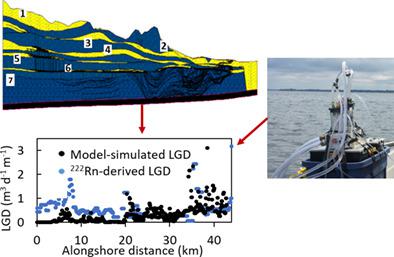当前位置:
X-MOL 学术
›
Hydrol. Process.
›
论文详情
Our official English website, www.x-mol.net, welcomes your feedback! (Note: you will need to create a separate account there.)
Evaluating lacustrine groundwater discharge to a large glacial lake using regional scale radon‐222 surveys and groundwater modelling
Hydrological Processes ( IF 3.2 ) Pub Date : 2021-04-08 , DOI: 10.1002/hyp.14165 Hayley Wallace 1 , E. J. Wexler 2 , Spencer Malott 2 , Clare E. Robinson 1
Hydrological Processes ( IF 3.2 ) Pub Date : 2021-04-08 , DOI: 10.1002/hyp.14165 Hayley Wallace 1 , E. J. Wexler 2 , Spencer Malott 2 , Clare E. Robinson 1
Affiliation

|
Lacustrine groundwater discharge (LGD) can be an important pathway for delivering pollutants to lakes but this pathway is often poorly characterized. Evaluating the potential impact of LGD on lake water quality requires understanding the magnitude and spatial variability of LGD, as well as understanding the age and flow paths of the discharging groundwater (e.g., recharge area, groundwater flow paths, and travel times). This study first compares LGD rates along two ~40 km shoreline lengths of a large glacial lake, Lake Simcoe, Canada, that were independently estimated via a radon‐222 (222Rn) field survey and via regional scale groundwater‐surface water modelling. Backward particle tracking analysis is then used to examine the age and flow paths of the LGD and thereby assess the potential for the LGD to deliver anthropogenic pollutants to the lake. The field and modelling results compare well with respect to the magnitude and spatial variability of LGD. However, the comparison highlights the need for well‐defined hydrogeological characterization if regional scale models are to be applied for LGD estimation. The particle tracking analysis indicates large variation in the groundwater flow path lengths and travels times (>1000 years to <50 years) for LGD along the shoreline. This illustrates that the LGD along different shoreline areas has varying potential to deliver anthropogenic pollutants to the lake. The study findings demonstrate the benefits of comparing independent field measured and model‐simulated LGD estimates, and moreover suggest that it may be possible, in some cases, to use existing regional scale groundwater‐surface water models, purpose‐built for other water resource and quality objectives, to conduct preliminary evaluation of LGD contributions to lakes. Preliminary model‐based evaluation would enable field efforts aiming to quantify and manage LGD to be better targeted rather than relying solely on regional scale field techniques that are often highly resource intensive.
中文翻译:

使用区域规模的radon-222调查和地下水模型评估湖水向大型冰川湖的排放
Lacustrine地下水排放(LGD)可能是将污染物输送到湖泊的重要途径,但这种途径通常很难被描述。要评估LGD对湖水水质的潜在影响,需要了解LGD的大小和空间变异性,以及了解排放的地下水的年龄和流动路径(例如,补给区,地下水流动路径和移动时间)。这项研究首先比较了加拿大冰川湖(Lake Simcoe)大型冰川湖在两〜40 km海岸线长度上的LGD率,这是通过radon-222(222Rn)实地调查,并通过区域规模的地下水-地表水建模。然后使用向后粒子跟踪分析来检查LGD的年龄和流动路径,从而评估LGD将人为污染物排放到湖泊中的潜力。现场和建模结果在LGD的大小和空间可变性方面进行了比较。但是,如果将区域规模模型应用于LGD估算,则比较突出显示了对定义明确的水文地质特征的需求。颗粒追踪分析表明,LGD在沿海岸线的地下水流径长度和传播时间(> 1000年至<50年)变化很大。这说明沿不同海岸线区域的LGD具有将人为污染物排放到湖泊中的潜力。研究结果表明,比较独立的实地测得的和模型模拟的LGD估计值的好处,并且还表明,在某些情况下,可能有可能使用现有的区域规模的地下水-地表水模型,这些模型专门为其他水资源和水资源而建。质量目标,以初步评估LGD对湖泊的贡献。基于模型的初步评估将使旨在量化和管理LGD的野外工作具有更好的针对性,而不是仅依赖于经常占用大量资源的区域规模的野外技术。专为其他水资源和质量目标而建造,以便对LGD对湖泊的贡献进行初步评估。基于模型的初步评估将使旨在量化和管理LGD的野外工作具有更好的针对性,而不是仅依赖于经常占用大量资源的区域规模的野外技术。专为其他水资源和质量目标而建造,以便对LGD对湖泊的贡献进行初步评估。基于模型的初步评估将使旨在量化和管理LGD的野外工作具有更好的针对性,而不是仅依赖于经常占用大量资源的区域规模的野外技术。
更新日期:2021-04-23
中文翻译:

使用区域规模的radon-222调查和地下水模型评估湖水向大型冰川湖的排放
Lacustrine地下水排放(LGD)可能是将污染物输送到湖泊的重要途径,但这种途径通常很难被描述。要评估LGD对湖水水质的潜在影响,需要了解LGD的大小和空间变异性,以及了解排放的地下水的年龄和流动路径(例如,补给区,地下水流动路径和移动时间)。这项研究首先比较了加拿大冰川湖(Lake Simcoe)大型冰川湖在两〜40 km海岸线长度上的LGD率,这是通过radon-222(222Rn)实地调查,并通过区域规模的地下水-地表水建模。然后使用向后粒子跟踪分析来检查LGD的年龄和流动路径,从而评估LGD将人为污染物排放到湖泊中的潜力。现场和建模结果在LGD的大小和空间可变性方面进行了比较。但是,如果将区域规模模型应用于LGD估算,则比较突出显示了对定义明确的水文地质特征的需求。颗粒追踪分析表明,LGD在沿海岸线的地下水流径长度和传播时间(> 1000年至<50年)变化很大。这说明沿不同海岸线区域的LGD具有将人为污染物排放到湖泊中的潜力。研究结果表明,比较独立的实地测得的和模型模拟的LGD估计值的好处,并且还表明,在某些情况下,可能有可能使用现有的区域规模的地下水-地表水模型,这些模型专门为其他水资源和水资源而建。质量目标,以初步评估LGD对湖泊的贡献。基于模型的初步评估将使旨在量化和管理LGD的野外工作具有更好的针对性,而不是仅依赖于经常占用大量资源的区域规模的野外技术。专为其他水资源和质量目标而建造,以便对LGD对湖泊的贡献进行初步评估。基于模型的初步评估将使旨在量化和管理LGD的野外工作具有更好的针对性,而不是仅依赖于经常占用大量资源的区域规模的野外技术。专为其他水资源和质量目标而建造,以便对LGD对湖泊的贡献进行初步评估。基于模型的初步评估将使旨在量化和管理LGD的野外工作具有更好的针对性,而不是仅依赖于经常占用大量资源的区域规模的野外技术。



























 京公网安备 11010802027423号
京公网安备 11010802027423号